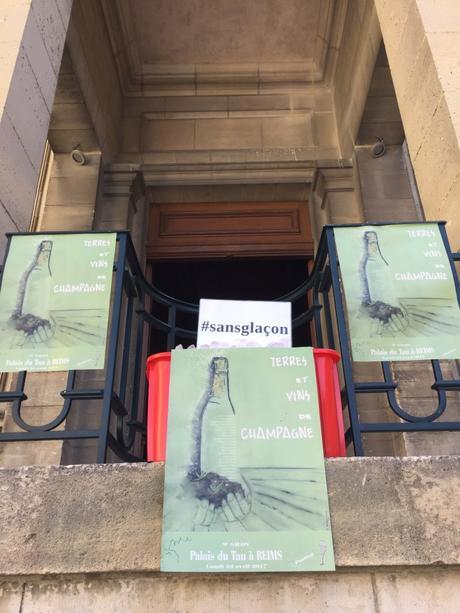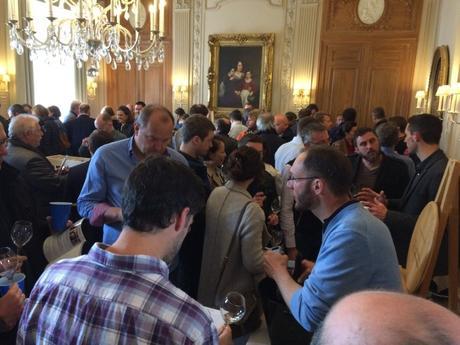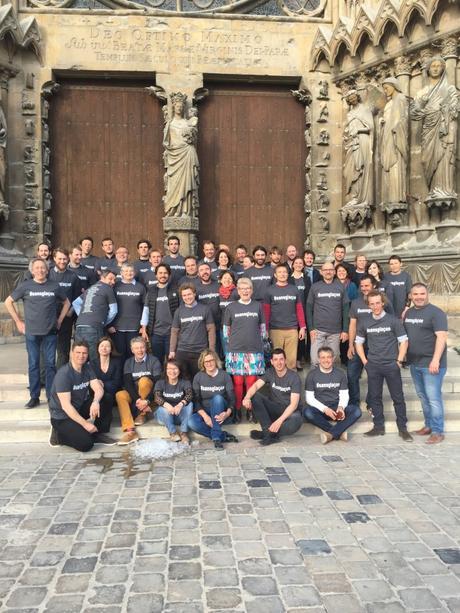Welcome to binNotes | redThread™
Inspired stories about wine and taste makers.
By L.M. Archer, FWS | Bourgogne ML
This week I share an embarrassment of riches with you as guest writer and international Champagne authority, author and journalist Caroline Henry takes on “The Real Meaning of Terroir in Champagne,” just in time for #Chardonnay Day on May 25, 2017.
I consider Caroline’s gracious reprisal as a guest wine writer here on binNotes | redThread™ a true honor and rare privilege, and hope you enjoy her rare insight into this year’s Le Printemps des Champagne equally fascinating – cheers!
You can view her feature on the topic of Bioenergetic Wines here.
You can read my review of Caroline Henry’s book Terroir Champagne here.

The goals of Le Printemps des Champagne is to illustrate the impact of terroir upon the grape variety in a specific vintage.
" data-orig-size="2448,3264" title="Entrance Terres et Vins de Champagne" data-image-title="Entrance Terres et Vins de Champagne" data-orig-file="https://binnotes.files.wordpress.com/2017/05/img_4799.jpg" style="width: 696px; height: 928px;" itemprop="http://schema.org/image" height="928" width="696" data-medium-file="https://binnotes.files.wordpress.com/2017/05/img_4799.jpg?w=225" data-original-height="928" alt="The second annual Le Printemps des Champagne included tasting events hosted by a variety of grower groups showcasing Champagne's diverse terroirs. Credit: ©Caroline Henry." data-original-width="696" data-image-meta="{"aperture":"2.2","credit":"","camera":"iPhone 6","caption":"","created_timestamp":"1493030058","copyright":"","focal_length":"4.15","iso":"32","shutter_speed":"0.0038759689922481","title":"","orientation":"1"}" data-large-file="https://binnotes.files.wordpress.com/2017/05/img_4799.jpg?w=638" /> The second annual Le Printemps des Champagne included tasting events hosted by a variety of grower groups showcasing Champagne’s diverse terroirs. Credit: ©Caroline Henry.“The Real Meaning of Terroir in Champagne Today”
by Caroline Henry
Terroir, the dark horse winning the champagne race
The second Les Printemps des Champagne has come and gone, and with it the more than 1,000 visitors who descended upon the region for the event. The particularity of this specific event is that it grew from a group of young Champenois’s desire to explain their terroir.
Nine years ago, 18 winemakers joined forces under the banner of Terres et Vins de Champagne, to organize a tasting showing off their vins clairs (still wines) as well as their champagne. The aim of the tasting was to show the impact of the terroir on the grape variety in a specific vintage. Raphael Bérèche, one of the founders of the event elaborates: “We wanted to show that Champagne also has a myriad of terroirs and that grape varieties have a different expression depending on where in the region they are grown.” The still wines were shown as it is often easier to notice the terroir differences there rather than in the champagnes.

The group Terres et Vins de Champagne launched
their first still wine and Champagne tasting day in Aÿ in 2009.
The first tasting drew a lot of interest from importers, trade and press, and after a successful second edition, other winegrowers decided to regroup and organize similar tastings. This in turn generated more trade and press interest, and more groups were created leading to the ‘officialization’ of the Printemps de Champagne. However, today’s twenty-two-tasting-event is a lot more about increasing one’s brand exposure than about explaining the terroir.
Can we deduct from this that when push comes to shove terroir still plays second fiddle in Champagne, at least beyond Grand or Premier Cru? I would argue against this, underpinning my position with a few observations from the Printemps the Champagne.
When we look at the attendance figures and the quality of visitors we quickly see that the events which continue to focus on terroir were a lot more popular than the others. Terres et Vins retained without a doubt its crown of most popular tasting of the week. Furthermore, the vins clairs only morning session had the most impressive trade and press presence. The session was by invitation only, and more than 250 people from all over the world attended to taste through more than 60 vins clairs. Some were looking to gather a better understanding of last year’s vintage, many just wanted to learn more about the various expressions of a grape variety across the different terroir. When asked why, the recurring answer was ; “it is important to understand the terroir to be able to better communicate about and sell the cuvees’. It seems customers prefer to know where and how the grapes are grown, rather than hearing about the technicalities of the winemaking. The latter is maybe also one of the reasons why tastings which focused predominantly on winemaking specifics drew only very few visitors, and often these visitors were champagne geeks, rather than decision or opinion makers.

Terres et Vins de Champagne began nine years ago when 18 winemakers joined forces to organize a tasting showing off their vins clairs (still wines) and
champagne.
Yet, even if there is a definite interest in tasting the vins clairs among the trade and press, it is important to note that showing one’s vins clair, especially at the same time as others, will expose a winemaker’s weaknesses.Hence why many groups participating in the Printemps de Champagne prefer to focus on their finished cuvees rather than the still wines, especially after the difficult and rather heterogeneous 2016 season. The still wines do not lie: unripe and/or over-cropped grapes often translate into thin and watered down wines, held together by not much more than acidity and sugar; they are unbalanced and tasting them can be quite painful. It was long accepted that these painful wines were what made the best Champagne. Tom Stevenson, creator of the Champagne and Sparkling Wine Atlas, once told me that the best vins clairs are “bland in taste bar for the high acidity as it is the latter which holds the aging potential.” This is maybe why most experts consider 2008 to be one of the great Champagne vintages, even if many chefs de caves will admit that overall the grapes were picked too early, and this is the reason why the cuvees can be quite acerbic when opened today.
Besides reasonable yields and ripe grapes, the soil management contributes significantly to the balance and flavor of the grapes and hence the vins clairs. Exchanging chemical herbicides for mechanical weeding or a natural grass cover forces the vine roots to expand vertically rather than horizontally. It also aerates the soil and thus enhances the accessibility of ground water for the plant. This water allows the vines to absorb some of the mineral elements of the mother rock which in turn enrich the grapes by adding a certain sapidity to the ripe fruit. According to Jean-Baptiste Lécaillon, cellar master at Champagne Louis Roederer, it is this “sapidity, rather than the acidity, which brings longevity to the wine.”
When we accentuate sapidity, which serendipitously also is the distinctive character of the terroir, we have one last reason why terroir (in the wider sense of the word) matters in the champagne making process; it is the dark horse which has been winning the champagne race through the creation of more pleasurable as well as wholesome cuvées.
❦
You can learn more about Le Printemps des Champagne here.

Sommelier Caroline Henry is the mover and shaker behind #WineStudio and PROTOCOL wine studio.
" data-orig-size="500,283" title="CarolineHenry" data-image-title="CarolineHenry" data-orig-file="https://binnotes.files.wordpress.com/2016/07/carolinehenry.jpg" style="width: 696px; height: 394px;" itemprop="http://schema.org/image" height="394" width="696" data-medium-file="https://binnotes.files.wordpress.com/2016/07/carolinehenry.jpg?w=300" data-original-height="394" alt="Caroline Henry. Image: Courtesy Caroline Henry." data-original-width="696" data-image-meta="{"aperture":"0","credit":"","camera":"","caption":"","created_timestamp":"0","copyright":"","focal_length":"0","iso":"0","shutter_speed":"0","title":"","orientation":"1"}" data-large-file="https://binnotes.files.wordpress.com/2016/07/carolinehenry.jpg?w=500" /> Caroline Henry. Image: Courtesy Caroline Henry.About the author:
Caroline Henry is a journalist, writer and educator specialized in terroir champagne. She lives in Hautvillers in Champagne and is the champagne correspondent for Wine-Searcher and Decanter.
Ever since moving to Hautvillers in 2011, Caroline began to specialize in the myriad of the Champagne terroirs and the different alternative viticulture practices. Through her extensive research Caroline has probably the most in-depth knowledge on organic, biodynamic and bioenergetics champagne. She has a personal relationship with many champagne makers and a comprehensive understanding of the region’s soil compositions and vinification methods. In March 2017, she self-published her first book Terroir champagne: the luxury of sustainable, organic and biodynamic cuvées which is available on Terroir Champagne.
More terroir champagne stories can also be found on her blog, Missinwine.
Story and images printed by permission of the author, Caroline Henry.
Copyrighted 2017 binNotes | redThread™. All Rights Reserved.

